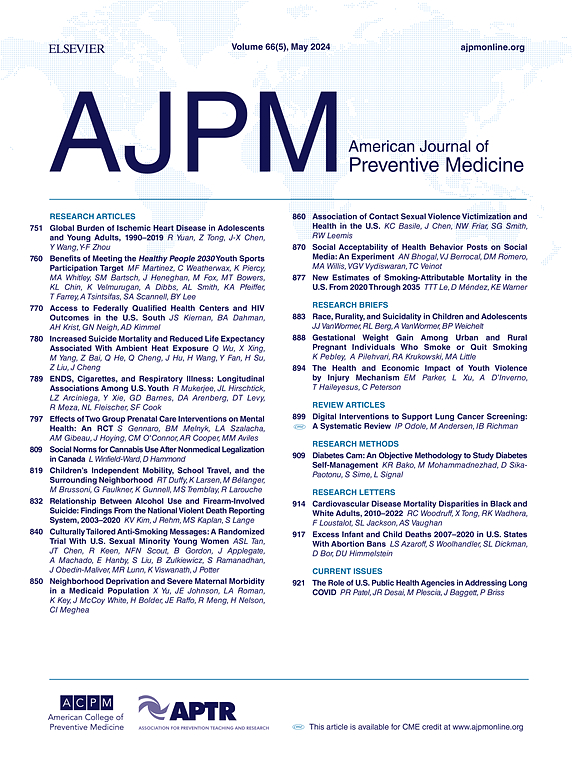重建低收入社区和居民心理健康:来自洛杉矶瓦茨自然实验的证据。
IF 4.3
2区 医学
Q1 MEDICINE, GENERAL & INTERNAL
引用次数: 0
摘要
引言:住房和建成的社会环境作为心理健康的社会决定因素的作用尚未得到充分研究。本研究利用一个正在进行的公共住房社区重建所创造的自然实验,来研究同时改善住房、建筑和社会环境对低收入、少数族裔居民心理健康的影响。方法:本研究分析了瓦茨社区健康研究中成年参与者的纵向数据。队列研究包括正在重新开发的公共住房社区的居民(治疗组)和洛杉矶瓦茨附近两个公共住房站点的居民(对照组)。采用ANCOVA回归模型,在基线(2018-19)和其他协变量的条件下,检验治疗组居民在随访(2021-22)时的心理健康评分是否优于对照组居民。分析利用了治疗组在再开发暴露中的合理外源性变异,以检查随访时的心理健康是否因靠近再开发地区而有所差异。结果:分析显示,治疗组在随访中出现的抑郁症状略少于对照组。他们还发现,在治疗组中,与重建地区的接近程度与居民的心理健康之间存在非线性关系。结论:低收入少数民族社区的综合再开发是一个复杂的过程,短期内对居民心理健康的影响是不均衡的。可能需要一些策略来帮助更均匀地分配这些好处。本文章由计算机程序翻译,如有差异,请以英文原文为准。
Redeveloping Low-Income Communities and Residents' Mental Health: Evidence From a Natural Experiment in Watts, Los Angeles
Introduction
The role of housing and the built and social environments is understudied as a social determinant of mental health. This study leverages a natural experiment created by the ongoing redevelopment of a public housing community to examine the effects of simultaneously improving the housing, built, and social environments on mental health for low-income, minoritized residents.
Methods
This study analyzed longitudinal data from adult participants in the Watts Neighborhood Health Study. The cohort study includes residents in the public housing community being redeveloped (treatment group) and those in two nearby public housing sites (comparison group) in Watts, Los Angeles. ANCOVA regression models were used to examine whether residents in the treatment group had better mental health scores at follow-up (2021–22) compared to residents in the comparison group, conditional on mental health scores at baseline (2018–19) and other covariates. The analyses leveraged plausibly exogenous variation within the treatment group in exposure to the redevelopment to examine whether mental health at follow-up varied differentially by proximity to the redeveloped areas.
Results
Analyses showed the treatment group experienced slightly fewer depressive symptoms than the comparison group at follow-up. They also revealed a non-linear relationship between proximity to redeveloped areas and residents’ mental health within the treatment group.
Conclusions
Comprehensive redevelopment of low-income minoritized communities is a complex process that entails uneven mental health impacts on residents in the short term. Strategies to help spread these benefits more evenly may be needed.
求助全文
通过发布文献求助,成功后即可免费获取论文全文。
去求助
来源期刊

American Journal of Preventive Medicine
医学-公共卫生、环境卫生与职业卫生
CiteScore
8.60
自引率
1.80%
发文量
395
审稿时长
32 days
期刊介绍:
The American Journal of Preventive Medicine is the official journal of the American College of Preventive Medicine and the Association for Prevention Teaching and Research. It publishes articles in the areas of prevention research, teaching, practice and policy. Original research is published on interventions aimed at the prevention of chronic and acute disease and the promotion of individual and community health.
Of particular emphasis are papers that address the primary and secondary prevention of important clinical, behavioral and public health issues such as injury and violence, infectious disease, women''s health, smoking, sedentary behaviors and physical activity, nutrition, diabetes, obesity, and substance use disorders. Papers also address educational initiatives aimed at improving the ability of health professionals to provide effective clinical prevention and public health services. Papers on health services research pertinent to prevention and public health are also published. The journal also publishes official policy statements from the two co-sponsoring organizations, review articles, media reviews, and editorials. Finally, the journal periodically publishes supplements and special theme issues devoted to areas of current interest to the prevention community.
 求助内容:
求助内容: 应助结果提醒方式:
应助结果提醒方式:


